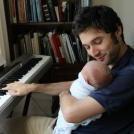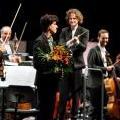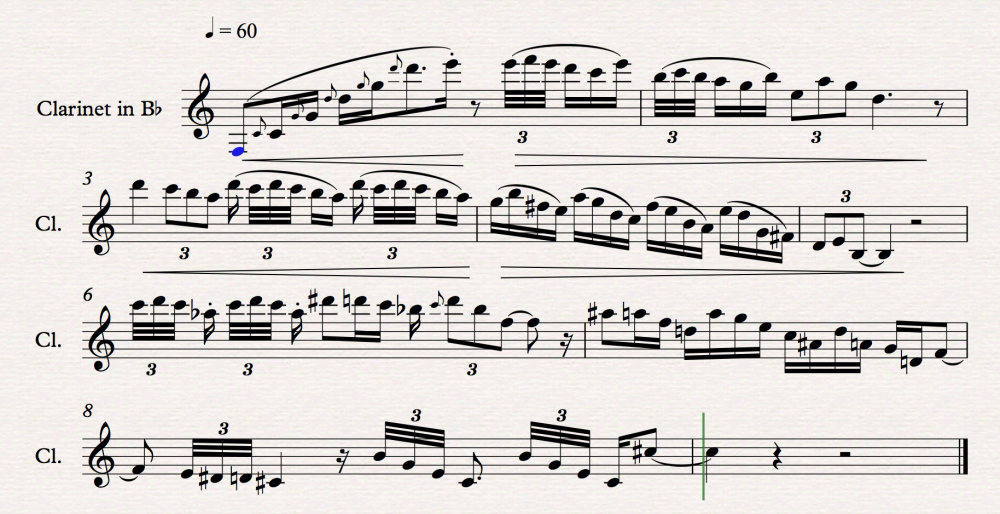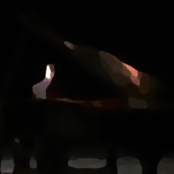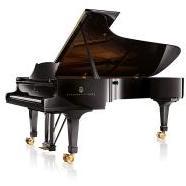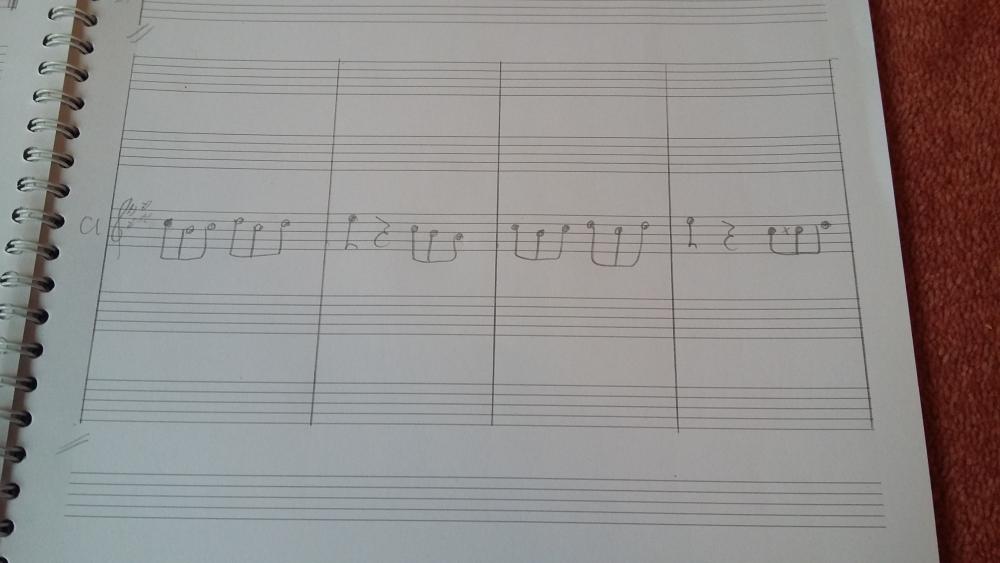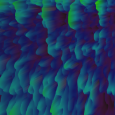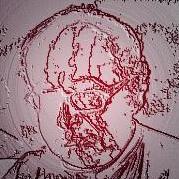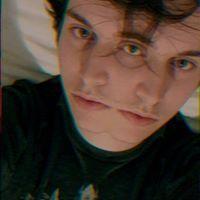Search the Community
Showing results for tags 'clarinet'.
-
This is my "Soliloquy for Clarinet No. 19". Here is the link to my previous posted soliloquy for clarinet: https://www.youngcomposers.com/t34671/soliloquy-for-clarinet-no-18/
-
The dogs’ meat was taken for human use, and Amoraq fed the team with pieces of old summer skin-tents raked out from under the sleeping-bench, and they howled and howled again, and waked to howl hungrily. One could tell by the soap-stone lamps in the huts that famine was near. In good seasons, when blubber was plentiful, the light in the boat-shaped lamps would be two feet high—cheerful, oily, and yellow. Now it was a bare six inches Amoraq carefully pricked down the moss wick, when an unwatched flame brightened for a moment, and the eyes of all the family followed her hand. The horror of famine up there in the great cold is not so much dying, as dying in the dark. All the Inuit dread the dark that presses on them without a break for six months in each year; and when the lamps are low in the houses the minds of people begin to be shaken and confused. But worse was to come. The underfed dogs snapped and growled in the passages, glaring at the cold stars, and snuffing into the bitter wind, night after night. When they stopped howling the silence fell down again as solid and heavy as a snowdrift against a door, and men could hear the beating of their blood in the thin passages of the ear, and the thumping of their own hearts, that sounded as loud as the noise of sorcerers’ drums beaten across the snow. One night Kotuko the dog, who had been unusually sullen in harness, leaped up and pushed his head against Kotuko the boy’s knee. Kotuko patted him, but the dog still pushed blindly forward, fawning. Then Kadlu waked, and gripped the heavy wolf-like head, and stared into the glassy eyes. The dog whimpered and shivered between Kadlu’s knees. The hair rose about his neck, and he growled as though a stranger were at the door; then he barked joyously; and rolled on the ground, and bit at Kotuko’s boot like a puppy. ‘What is it?’ said Kotuko; for he was beginning to be afraid. ‘The sickness,’ Kadlu answered. ‘It is the dog sickness.’ Kotuko the dog lifted his nose and howled and howled again. To learn more about this music, please visit: https://www.senigaglia.com/quiquern-dog-sickness/
-
This piece is called "The People of the Elder Ice." As you listen, picture an Inuit village, alone at the edge of the world, surrounded on all sides by a frozen waste. Survival is a daily struggle, food is often scarce, and the fickle arctic gods constantly toy with the villagers... yet somehow the people thrive. (I've posted this music before, but now you can watch the music as you listen).
-
Okay so here's my first kind of 'major' piece I've written for my degree. It'll be performed by a professional ensemble in May, and I'm sending off the score this week. The brief was to write a piece of maximum length 12 minutes, for an ensemble of maximum size flute/clarinet/perc/2 violins/viola/cello/bass. After a bit of agonizing over what on earth I would do, I did what usually works for me and just sat down and put some notes out to see what happened, and then went from there. The piece is kind of loosely following around a character as he explores a world. I haven't put too much more thought into the precise story than that, except that the first movement is introducing the character, and the second and third are two little adventures of his, with the third ending in his triumphant return. I kept a fairly light tone throughout, which seems to be a common thread for all my compositions. Some of my tutor's suggestions that I put in were expanding the first movement slightly, experimenting with string harmonics, and just some general score tidying. He liked the ending and I do too - his comment was that it sounded like something a composer might have written a hundred or so years ago, but in a good way. The piece is fairly tonal, almost to a fault at times, so mostly my concerns were with trying to keep it as fresh and interesting as I could, in my own ways. Mainly, that involves trying to vary up my chord progressions and harmonies. I had particular fun towards the end of the second movement where I literally was just putting in whatever I felt like in the strings. The title has no significance whatsoever, except that I wanted it to evoke something childlike and innocent. I originally had 'Tinky-Winky' instead of 'Timmy' but my tutor thought that was going too far, and it would seem like I was going for a jokey piece, which was not quite my intention. Recording is a slightly dodgy/quirky/stuttery Sibelius output but it's mostly okay.
-
Hey everyone! It's been a very long time! I first joined here around a decade ago, and never stopped composing! I've since moved to Sweden from the US, and am studying composition at a conservatory here. I wanted to share my first big project from last term, where we were to compose for a chamber ensemble of fantastic musicians (Norrbottens NEO, in case you're interested). As first years, we weren't on their actual recital and were encouraged to write music as difficult as we wanted and try new things. Unfortunately, their percussionist was ill on the day of the rehearsal/recording, and we only had about an hour each to rehears and record, so it didn't turn out as great as I had hoped. It was still an awesome learning experience, and given a few more hours of rehearsal I'm sure it would have turned out great. In lieu of that, I'll attach both the midi and the recording, as well as the score. The ensemble is for flute, clarinet, violin, viola, cello, piano, and percussion. Instead of writing one piece, I decided to write four short movements, each one exploring a different idea. The first two are played as one, and explores some cool scales (double harmonic major as well as a fully diminished locrian), the third movement deals with time signatures/rhythm (and, seeing how the percussionist that was there that day was sight reading, I think he did fantastic), and the fourth movement was to see how much I could have acoustic instruments sound like synthesizers in a dubstep-like movement. Obviously it's a finished piece, but any and all feedback would be welcome! I hope to be posting here more and getting to know the new people as well as catching up with the old ones :D
-
Quiquern Part One: The People of the Elder Ice One of my favorite short stories of all time is “Quiquern” by Rudyard Kipling, from The Second Jungle Book. If you’ve never read the two Jungle Books, I highly recommend them. The Disney film only scratches a tiny surface compared to the epic stories by Kipling (Mowgli’s story is really only the first of like 20 stories). The writing is so crisp, and these stories do what all great sci-fi and fantasy stories do: they create an entire fully-formed world for the reader to explore. The world is rich and complex, and the lessons it teaches are piercing and difficult to shake. The Disney film is fun and jazzy and hip and carefree; the written stories are raw and wild, filled with the brutal poetry of the jungle. The characters are bound by the laws of the jungle, the unwritten rules and shared understandings that guide every action the animals take. The laws dictate how to behave in times of drought, when and where hunting is permitted, and how to interact with the ever-expanding, dangerous world of Men. Only Mowgli is unbound by the laws of the jungle. Therefore he rules the jungle. Mowgli = boss There are also so many hidden messages and deeper meanings packed into Kipling’s verse. Every story begins and ends with poems, the meanings of which change after reading each story. For example, this one: The night we felt the earth would move We stole and plucked him by the hand, Because we loved him with the love That knows but cannot understand. And when the roaring hillside broke, And all our world fell down in rain, We saved him, we the Little Folk; But lo! he does not come again! Mourn now, we saved him for the sake Of such poor love as wild ones may. Mourn you! Our brother will not wake, And his own kind drive us away! At first reading, it is a nice little poem. But after reading the story that follows it, “The Miracle Of Purun Bhagat,” the poem becomes so tragic and beautiful. Every story has these lovely little nuggets, and they make the reading experience so rich. “Quiquern” is the story of a young Eskimo boy who lives in a tiny village surrounded by a frozen arctic wasteland. The village’s only source of food is seal meat which they catch with the help of their many well-trained dogs. One particular dog is born a runt, shrunken and sickly in the freezing wind. However the young boy cares for the dog, and raises him as a member of his own family. His love for the dog is pure and innocent, and together they frolic in the snow like siblings. One year the winter is especially harsh, and the ice does not recede. The surplus seal meat runs out, and the people of the village soon begin to starve. In their moment of desperation they eat the wax from their candles, the leather from their belts. Their beloved sled dogs, still chained together in groups of eight, insane with hunger and fearing for their lives (just as lion cubs must fear their mother in times of hunger) break their chains and run screaming into the white waste. The people of the village become living skeletons. The boy and a young girl from the village, still strong in their youth, announce to the village that they will venture out into the ice storm and find food for the village. It is suicide, but nobody stops them. Within days of their departure they are hopelessly lost, freezing, and beginning to hallucinate. They kneel shivering in the snow and announce to the heavens that they are man and wife. As darkness closes around them they pray to Quiquern, the eight-legged spider god of the arctic, for salvation and mercy. In the morning, as light slowly creeps over the white hills, the two children open their eyes to see a massive creature barreling toward them in the distance, eight legs scurrying effortlessly across the snow. A giant, hulking body becomes larger and larger in the morning haze. Quiquern has arrived to devour them; they are helpless as newborn seals. It is the end of their short lives, the end of their people. Two freezing, starving children prepare to die alone on a frozen plain at the edge of the world. However as their eyes focus, they soon realize that the eight-legged creature is actually eight dogs, running wildly through the snow pulling an empty dogsled. The dogs are well-fed and excited, blood dripping from their snouts. At the front of the pack is the runty dog the young boy once saved, frothing with joy at the sight of his oldest friend. Carried by the sled dogs, the two Eskimos travel for miles to an open pit in the ice, where fat seals emerge for air. The dogs had found the hole in the ice and gorged themselves on meat. The boy and his wife fill the sled with food and return to the village as heroes. The village, now inhabited only by ghost-like creatures with sunken eyes, celebrates by burning whatever candles they have left. An ancient people go on. This story burrowed down inside me and left its mark on my soul. I’m not sure why, I can’t explain it, but it filled me with the urge to write music. Originally I set out to write something eerie and cold and empty, three flutes crying out across the Arctic plain. But as I wrote, I realized it needed some bass, so I worked a piano into the mix. Years later, I switched out a flute for a clarinet to give it one more color, and that ensemble is the one that remains. I’ve always loved my piece, Quiquern, just as I’ve always loved the story Quiquern. I can’t exactly say what it is that draws me to both, but drawn I am. Over the years I’ve written notes about this music in the margins of my journal: “Don’t forget, you love Quiquern. Don’t discard it.” Quiquern Part Two: The Dog Sickness The second movement is called “The Dog Sickness”. I thought “Quiquern” was complete years ago. Time and again I would declare it officially finished. But then, months later, something just wouldn’t sit right with me. I’d pry it open again and tinker with its innards. Maybe it will never be done. Maybe I’m destined to dance with this score til the end of my days. Don’t get me wrong, I have always loved this music. Every time I pick it up again, I’m reminded of why I have such a sweet spot in my heart for “Quiquern”. It evokes so many positive memories: of writing it over Christmas break in San Diego, of reading The Jungle Book over and over, of experimenting with new sounds (new to me anyways), of unhinging my creativity from purely classical harmonies and letting go a bit. Like this sort of thing: I never go full atonal, I’m always chained in some way to classical forms and progressions, but this piece freed me up in some ways I had never tried. I went wandering a bit through the cold wilderness. I let the images in my mind solidify into a color palette. I focused on the story the sounds told, rather than fussing about the progression. This allowed me to express all the pain I felt after reading that beautiful, heart-breaking story. A forgotten people, starving alone at the edge of the world. So why, if this music was so compelling, couldn’t I call it “complete”? Well there were a few reasons. One is I just wasn’t thinking about form when I first wrote it. I was in “crank it out” mode, writing down whatever ideas popped into my head. I tried to free up my creative process and stop self-editing as I wrote. As a result, the music flowed pretty freely out of my brain, and the harmonies were weirder than I was used to. The musical nuggets that emerged were captivating and exotic. But there was no overarching shape to the piece. It was just idea after idea, with very little connectivity. Throwing a bunch of nuggets into a pile don’t make it a whole chicken. This time around I wanted to work on that. This is the sort of pre-thought that Schoenberg went on about. In other words, real composers think about form and structure BEFORE writing, they don’t just wander around in the dark hoping to bump into a complete form. When I put some thought into this piece, I was able to picture the arc that I wanted to create with the music. A chaotic, hallucinogenic dream sequence, sandwiched on either side by a poignant but solitary theme calling out in the dead stillness of the ice-fields. Perhaps the middle is what the dogs feel as they begin to starve, giddy and terrified and angry; the beginning is what the Inuits feel watching their beloved animals suffer in the dark, knowing what awaits them if another source of food is not found soon. “What is it?” said Kotuko; for he was beginning to be afraid. “The sickness,” Kadlu answered. “It is the dog sickness.” The dog lifted his nose and howled and howled again. “I have not seen this before. What will he do?” said Kotuko. Kadlu shrugged one shoulder a little, and crossed the hut for his short stabbing-harpoon. The big dog looked at him, howled again, and slunk away down the passage, while the other dogs drew aside right and left to give him ample room. When he was out on the snow he barked furiously, as though on the trail of a musk-ox, and, barking and leaping and frisking, passed out of sight. His trouble was not hydrophobia, but simple, plain madness. The cold and the hunger, and, above all, the dark, had turned his head; and when the terrible dog-sickness once shows itself in a team, it spreads like wild-fire. Next hunting-day another dog sickened, and was killed then and there by Kotuko as he bit and struggled among the traces. Then the black second dog, who had been the leader in the old days, suddenly gave tongue on an imaginary reindeer-track, and when they slipped him from the pitu he flew at the throat of an ice-cliff, and ran away as his leader had done, his harness on his back. After that no one would take the dogs out again. They needed them for something else, and the dogs knew it; and though they were tied down and fed by hand, their eyes were full of despair and fear. To make things worse, the old women began to tell ghost-tales, and to say that they had met the spirits of the dead hunters lost that autumn, who prophesied all sorts of horrible things. Prayers to a cruel and fickle ice god. Now the music told a story. And while I was working on form, I also put more thought into motifs. This piece has a lot of rich material, maybe even too much. Though I love that there are so many fun ideas in there, sometimes it plays like one of those Beatles songs with too many good ideas but no development. This time around I went through the piece with a needle and thread, and wove my favorite motifs into the very fabric of the piece. In and out they come, appearing and disappearing again, becoming more recognizable with each appearance. Just as a chef might pour a bit of the boiling gnocchi water into the sauce to bind all the flavors together, my goal was to bind all the ingredients of this music together into something coherent (and tasty). Like this motif, which appears everywhere: Or this rhythmic motif: Just because Beethoven used it in his fifth symphony, doesn’t mean it’s off-limits forever. There was something else fundamental that needed retooling: instrumentation. Originally I chose three flutes and piano for this piece, because the flutes evoked the lonely, frozen tundra. But as I was writing, I didn’t pay enough attention to the limitations of the flute. I wasn’t writing in an idiosyncratic way, I was just cranking out music. The used a lot of low C’s on the flute because I liked the sound, but I knew the notes were ringing out stronger in my head than they would on a real instrument, where that low C is easily covered up and lost in the mist. I considered an alto flute, but decided a clarinet would give me a whole other palette to play with. When on phases in a new instrument like this, one can’t just paste the flute part into a clarinet staff and call it done. The addition of the clarinet changed the whole character of the piece. While the flute is cold and isolated and graceful and metallic, the clarinet is like warm baking bread. It’s also intense, frenetic, a bit insane at times, with low earthy tones that can feel angry or foreboding or subdued. That new voice greatly expanded the range of the piece, so I was able to open the music up a bit and let it breathe. All these forces combined into something much different than the piece I’ve been kicking around all these years. This version feels like a completed piece of art. It’s not just a sketchbook of ideas, it’s a story arc with real meaning. In other words it really does feel done. For real this time. Seriously. Now I have the final movement to think about, but I might just put this piece down for a while, maybe a year or two. I want to orchestrate something!
-
Hello! [Partly the description in the program booklet and youtube video] Maarten Bauer – Melodrama No.1 ''The End of His Story Started Here,'' Op. 45. 11th of August 2017 Dedicated to all the victims in concentration camps during World War II. The music begins at circa 2:00 On the 18th of November 2017 (one of the) most prestigious composition competition(s) in the Benelux took place: Prinses Christina Compositie Concours. I submitted my Melodrama No.1 ‘’The End of His Story Started Here’’ and to my surprise I won the first price of competition! I cannot express my gratitude for the judges, the performers (Trio Burlesco+) and the audience! Furthermore I would like to thank the other participating composers for the amazing experience and relaxed atmosphere during the stressful day. Description This melodrama uses the poem, which I have written in 2014 (see the text below), based on John Boyne’s astonishing book The Boy in the Striped Pyjamas. This composition is composed for the Trio Burlesco and a soprano and a percussionist (Trio Burlesco+). The text and music strengthen each other, so none of the two can be omitted. The innocent soprano is both narrator and singer and she symbolizes the actions, the emotions and the thoughts of the main character in the poem: Shmuel. Shmuel is a Jewish boy, who has just arrived in Auschwitz, which is called Out-With by Boyne. He does not know where he is and he cannot find his family, consisting of his father, mother and his big sister, whom I called Anat, which means ‘singing.’ The motivation for me to write such a heavily-weighted piece, namely an innocent young boy who will probably die in a Nazi concentration camp, is because I noticed that people in my surrounding realize less and less that freedom and peace are not obvious. It is the greatest gift that we can live in freedom and peace in the Netherlands. I noticed that this important consciousness gradually drains away by the years. Therefore I wanted to compose a piece, which remembers us that we have to be grateful for the lives we now live and that the indescribable terrible crimes may never be repeated. When I wrote the poem, my tears flowed. When I composed the Melodrama, my tears flowed. And now again, my tears flow, because this may never happen again. Never. https://christinaconcours.nl/alles/9667/
-
Hi, I was hoping I could get some advice on a clarinet solo I am writing for my audition portfolio. I only play guitar, but I wanted to write a solo for clarinet to add some variety to my portfolio. I am worried that the phrasing that I'm coming up with isn't particularly suited to the clarinet or any wind instrument for that matter. I am using Instrumentation and Orchestration by Alfred Blatter to get a better idea of what I can and cannot do on clarinet. If anyone who plays clarinet could give me some advice on if the piece is playable that would be great. Any advice on the composition itself is also welcome. I'll upload a screenshot of the first 9 measures of the score (rough; haven't add in the dynamics or other markings yet) along with a rough playthrough of how I would like it to sound on guitar. Also, if anyone knows of any solo clarinet pieces I could study to get a better grasp on what it would be more fitting for the instrument, that would be very helpful. Thanks!
-
Here is a piece I hope to compliment with two more pieces for a more complete sonata -- this is only the first movement. I've spent a while working on making my writing more concise for chamber settings, and once I actually write this whole piece, I plan on getting it performed and recorded. A large focus on this piece is varying textures and moods efficiently, as well as using the different motifs and melodic fragments to construct the music, concerning myself less with harmonic relationships etc. I've included a score in concert pitch, as well. Suggestions are helpful, and thanks! P.S. I attached a poem by William Carlos Williams, which helped me start the piece P.P.S. I appreciate all the comments, especially on the difficulty of the piano part, and when I finally incorporate this piece into a full sonata, I might re-evaluate certain places. The feedback helps a ton!
-
Is it possible to cross the break easily on a Bb clarinet once or twice in a quick line? I am writing a Tarantella for Wind Quintet and the Bb Clarinet gets a quick line.
-
Another old(-ish) piece. I had to write it for an interview at the Royal Academy of Music when I was applying for conservatoires at the beginning of the year. I was given the brief, a week or so before my R.A.M. interview, to compose a miniature of 60-90 seconds duration for two instruments of my choice using the collection of notes and intervals, D, F#, C, G, E.
-
Again, I was not sure whether this qualifies for the chamber music or the large ensemble category, but here it is. Powder Peony Waltz is a Viennese waltz written for whatever group of instruments I like (modified orchestral ensemble with ornaments in the form of a piano and celesta). I know that the transition between different keys is extremely awkward and chord progressions are not very fancy, but I was simply asked to write a quick small piece for dance class at my high school for their annual ballroom dance show. I intended to make this sweet, flowery, and light. Thank you for listening an enjoy!
- 3 replies
-
- viennese waltz
- waltz
-
(and 13 more)
Tagged with:
-
Sonatina for a duo of Clarinet and Viola
- 1 reply
-
- chamber music
- duo
-
(and 4 more)
Tagged with:
-
Hi I've been working on something simple but funny (for me). Inspired in the life of my cats, I'm doing a king of little suite for flute, clarinet and piano. The clarinet is not transposed in the score. Well, music for me is this, too... T I've written too pieces (working on more): Awakening: the moment when the all come back from the dreamworld. Purring: including the sound of Dexter.
-
Hello everybody, A few months ago I discovered minimal music and I immediately fell in love with the simplicity and rest it gives me. At the moment minimal music is one of my favourite genres and I tried to compose a minimalistic piece for Clarinet in A or Bb. Melody for Clarinet.pdf The score is already transposed, so the part will sound different when played by a Clarinet in A than than when played by a Clarinet in Bb. The performer can choose how many times he or she wants to play the repetitions. Glass' masterwork Glassworks is a huge inspiration for this piece. Check it out! (the title of another minimalistic work by Reich) https://www.youtube.com/watch?v=6Stu7h7Qup8 Check it out! https://www.youtube.com/watch?v=GqXhvPIgDL8 Feedback or any comments would be nice! Maarten
-
I wrote this for a composition assignment in which we were tasked with writing a twelve-tone piece for 2 instruments. For this piece I utilized five permutations of the original row. I've attached the score, which right now is simply the notes- it doesn't contain any dynamics or articulations. I'm still very new to twelve-tone technique, so I'm not sure I have the twelve-tone sound in my ears yet, but if anyone here has experience with twelve-tone technique I would greatly appreciate your thoughts on how I did!
- 17 replies
-
- 1
-

-
- twelvetone
- clarinet
-
(and 1 more)
Tagged with:
-
Hi everyone! I wrote this piece, "Penumbra", at the request of a teacher, and I liked how it came out. The inspiration musically was based around progressive rock and jazz fusion structures and harmony. I have only a little experience with clarinet and cello, so I'm not sure whether all of the fingerings are ideal. I'd be very grateful if any players of those instruments could give me feedback on that. Penumbra.pdf Penumbra.mp3
-
Here's an older work of mine that I'm thinking of writing a sequel to. I would be interested in folks' opinions about what works and what doesn't. The basic "story", such as it is, is that the three instruments are three separate characters who are constantly taunting each other. It finally gets to be too much for the piano, who slowly loses it over the course of the piece. Thanks!
-
Hi all, I have (finally) completed my Quartet for Piano and Winds. I have completed the first and second movement in August, but I was not able to compose a third movement, until last week. When I listened to Mozart's Quintet for Piano and Winds, K.452. I decided to compose a Quartet, which could be played by my friends and me. This is the reason why it is written for Bb Clarinet, Alto Saxophone, F Horn and Piano. I have tried to compose the third movement in the same style as the other two movements. Feedback and sharing your opinions would make me very happy! Enjoy! Kind regards, Maarten Bauer
-
This is my 18th soliloquy for clarinet (in Bb). It is one of my longer soliloquies, and one of the best ones in my opinion. As usual, the score is the transposing one. Here is the link to my previous clarinet soliloquy: http://www.youngcomposers.com/t33963/soliloquy-for-clarinet-no-17/
-
Alto Saxophone Concertino No.1 in f minor ‘’Batterij’’, Opus 14 Dear reader / listener, I composed this concertino on the 14th of July for a national composition competition in Holland. The piece is about my black-out, which I had last school year. The composition is originally written for members of the Jong Nederlands Blazers Ensemble (Young Dutch Wind Ensemble) and me as soloist: Alto saxophone; oboe; clarinet in B-flat; horn in F; bassoon. Feedback would be very nice, because I have not received much useful feedback from the judges at the competition. Kind regards, Maarten Bauer (16). Nota bene about the video: We had to practise the composition in less than fifteen minutes, so there are some mistakes. In my opinion it still sounds better than when it is played by a computer.
- 4 replies
-
- concertino
- alto
- (and 13 more)
-

Dystopian Dream (Brave New World prelude, Opus 18)
Guest posted a topic in Orchestral and Large Ensemble
A small prelude written for my English class - background music for a model based on the setting from A. Huxley's "Brave New World". In this composition, I tried to reproduce the cheap and ignorant, grotesque cheerfulness of Huxley's bizarre world of artificiality. Also, I thought that the concept of all-seeing eye would fit the dystopian nightmare. The pillar of this prelude is my loose improvisation in A major - one of the most happy and cheery keys, in my opinion. Thank you for listening!- 10 replies
-
- orchestral
- thematic
- (and 18 more)


